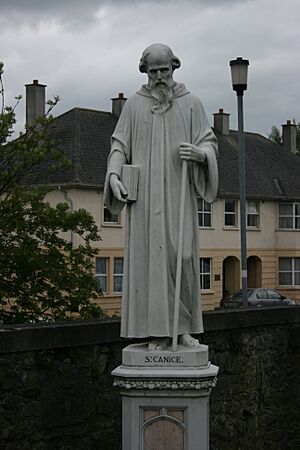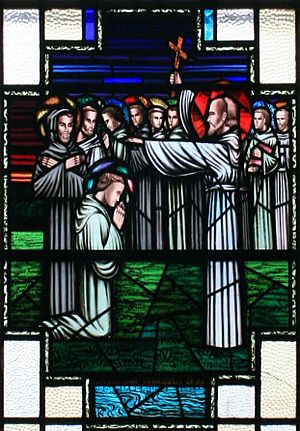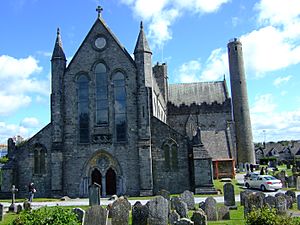Cainnech of Aghaboe facts for kids
Quick facts for kids SaintCainnech of Aghaboe |
|
|---|---|

Saint Cainnech statue in Kilkenny
|
|
| Confessor | |
| Born | c. 515 A.D. Glengiven, Cenél nEógain, Gaelic Ireland |
| Died | 600 (aged 84–85) Aghaboe, Laois, Gaelic Ireland |
| Venerated in | Roman Catholic Church Eastern Orthodox Church Anglican Communion |
| Canonized | pre-congregation |
| Feast | 11 October 1 or 14 August |
| Patronage | the shipwrecked |
Cainnech of Aghaboe (born around 515/516, died 600 AD) was an important Irish saint. He is also known as Saint Canice in Ireland and Saint Kenneth in Scotland. He was a leader of a monastery, a founder of churches, a priest, and a missionary during the early medieval period.
Cainnech was one of the Twelve Apostles of Ireland. These were twelve important students who helped spread Christianity across Ireland. Cainnech also preached to the Picts in Scotland. He wrote a special book explaining the Gospels, which was famous for centuries. It was called the Glas-Choinnigh, meaning Kenneth's Lock or the Chain of Cainnech.
Most of what we know about Cainnech comes from old stories and traditions. However, he was known as a very good person, a great speaker, and a learned scholar. His special day is celebrated on 11 October in the Roman Catholic and Eastern Orthodox Churches. Some also celebrate him on 1 or 14 August.
Contents
Who Was Saint Cainnech?

Much of what we know about Cainnech comes from old legends. However, a writer named Adomnán (who died in 704 AD) wrote about him. Adomnán was an abbot at Iona and wrote a famous book called Vita Columbae (Life of St. Columba). This book mentions Cainnech, showing he was a real person.
Cainnech's Early Life
Cainnech was born around 515 or 516 AD. His birthplace was Glengiven, near Dungiven in Ulster, which is a northern part of Ireland. His full name was Cainnech moccu Dalánn.
His father, Lughadh Leithdhearg, was a skilled bard. Bards were highly trained poets who traveled and told stories. Lughadh settled in Glengiven and became a teacher to the local chief's son.
Cainnech's mother was named Maul or Mella. She was also considered a very holy person. A church near Kilkenny city was dedicated to her.
Learning and Becoming a Priest
In early Christian Ireland, many people became interested in learning. Monasteries became important centers for studying Latin and Christian teachings.
Cainnech spent his early years looking after his chief's animals. In 543, he began studying at Finnian's monastic school at Clonard. This monastery was very famous in the 6th century. Many important Irish Christian leaders studied there.
Cainnech was one of the "Twelve Apostles of Ireland." These twelve students became very influential in spreading Christianity. At Clonard, Cainnech also became good friends with Colmcille (Columba).
In 544, Cainnech continued his studies at the school of Glasnevin. He studied with other future saints like Kieran of Clonmacnoise and Comgall of Bangor. When a plague caused that school to close, he went to Cadoc's monastery in Wales. There, he became a priest in 545.
After his studies, he traveled to Rome to receive a blessing from the Pope. By 550, he had returned to Glengiven. He helped convert his foster-brother, Geal-Breagach, who then helped him start a church in nearby Limavady.
Cainnech in Scotland
In 565, Cainnech joined his friend Columba in Scotland. In Scotland, he is known as Kenneth. Adomnán wrote about Cainnech's arrival on Iona. He said that Columba had a vision that a "holy and excellent man" would arrive that evening. Even though the sea was stormy, God gave Cainnech a safe journey. Columba welcomed him with great honor.
Cainnech helped build a church in the area now known as Saint Andrews. He also built small monastic homes on islands like Ibdon (possibly South Uist) and Eninis. He founded a small chapel called Lagan-Kenny near Loch Laggan. He also started a monastery in Fife by the Eden River.
Saint Cainnech might have been very important in bringing Christianity to South Uist. His name is still remembered in places like the ruins of an old church, Kil-Chainnech on Tiree. There is also a burial ground called Kil-Chainnech in Iona and an island called Inch Kenneth near Mull.
Returning to Ireland
Cainnech spent a lot of time in County Meath and Ossory. Ossory is now part of County Laois. He was well-respected by the king of Ossory, Colmann. King Colmann gave him land, including Aghaboe. Aghaboe means "the field of the Ox." This became Cainnech's main monastery.
Aghaboe became very important. In the 7th century, it sent a missionary named Feargal to the church in Salzburg, Austria. For a time, Aghaboe was the center for the local bishop. However, in the 12th century, this center moved to Kilkenny. In 1346, the town of Aghaboe was burned, and Cainnech's shrine and relics were destroyed.
The city of Kilkenny (Irish: Cill Chainnigh) means "The Church of Cainnech." This name originally referred to a church built by or dedicated to Cainnech. Later, the name was used for the whole town and area. Kilkenny was one of the last places in Ireland to become Christian.
Tradition says that in 597, Cainnech led Christians to Kilkenny. They wanted to end the last stronghold of the old Druid religion in Ireland. The last Archdruid and his council had hidden in a mound in Kilkenny. Cainnech led his followers there and overcame them. He then founded a monastery near where St. Canice's Cathedral stands today. He passed away and was buried at Abbey of Aghaboe around 599 or 600 AD.
The Chain of Cainnech
When he was older, Cainnech went to an island in what was once Loch Cree. There, he wrote a special book that explained all four Gospels. This book became known as Glass Kinnich or the Chain of Cainnech. It was kept safe in his church for a long time. It became a very important commentary during the Middle Ages.
Special Protection
Cainnech is the patron saint of Aghaboe. He is also one of the patron saints of Kilkenny and the historic kingdom of Osraige, along with Ciarán of Saigir. Cainnech is also known as the patron saint of people who have been shipwrecked.
See also
- Twelve Apostles of Ireland
Places Named After Saint Cainnech
- Kilkenny City (Irish: Cill Chainnigh), Ireland.
- County Kilkenny, Ireland; named after the city.
- St. Canice's Church in Finglas, Dublin.
- Llangennech (Church of Cennych) in Carmarthenshire, South Wales.
- An ancient church, Kil-Chainnech on Tiree Island, Scotland.
- A burial ground, Kil-Chainnech, in Iona, Scotland.
- An oratory called Lagan-Kenny on the shores of Lough Laggan, Scotland.
- Kilchenzie in Cantyre, Scotland.
- The remains of St Kenneth's Church near Loch Laggan, in Scotland.
- St. Canice's Church in Katoomba, New South Wales, Australia.
- St. Canice Church, Roslyn Street, Sydney, Australia.
- St. Canice Church, Nevada City, California, USA.
- St. Kenneth Church, Plymouth, Michigan, USA.
- St Canice's Church and St Canice's School in Westport, New Zealand.
- St Canice's Church in Lockington, Victoria, Australia.
- Mount Saint Canice convent in Sandy Bay, Tasmania, Australia.
- Church of St. Canice, Kilkenny, Minnesota, USA.
A Prayer for Saint Cainnech
This is a special prayer, called a Troparion, for Saint Cainnech: In honor, you are like Ireland's great teacher, O Lover of the quiet desert, writer of holy songs, Father of Monks and Founder of Monasteries, O Father Cainnech. Working hard for Christ, both in your home country and in Scotland, you never stop praying for those who believe. Pray for us who sing your praises, so that even with our weaknesses, we may receive great kindness.




